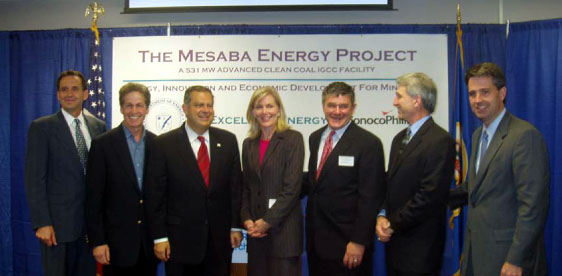Pawlenty toadies on parade for IGCC
July 30th, 2007

So late on Thursday afternoon, there’s a filing in the inbox from the “Department of Commerce” with none other than Pawlenty-appointed Deputy Commissioner touting the Mesaba Project, despite the expert analysis of his own Dept. of Commerce!!! We fired off an objection and Minnesota Power fired off an objection, YES!!!
What’s wrong with this picture? Here’s the Gov’s boy sending this letter directly to the Commissioners! Had I done that, they’d probably shoot me! The record closed MONTHS AGO, and he’s got no business leaning on the Commissioners directly, I don’t care who he owes what, I don’t care if Pawlenty owes Excelsior — though I do care what exactly Pawlenty owes them and why!!!
Here are the objections filed thus far:
I hope everyone will read the Staff Briefing Papers:
Here’s the Twin West Chamber toadying for Excelsior:
And join us for tomorrow’s festivities at the PUC:
Excelsior’s Mesaba Project
Oral Argument – Tuesday July 31, 2007 @ 9:30 a.m.
Deliberations – Thursday, August 2, 2007 @ 9:30
Public Utilities Commission
121 – 7th Place East, St. Paul
Large Hearing Room, 3rd Floor
Odd word, “deliberation.” Whatever the result, this will be INTERESTING!!!
Come on down!!!
Complaint filed re: Excelsior Energy ex parte contact
July 30th, 2007

Oh, there they go again, ass over teakettle, overboard in a desperate attempt to change the tide. When will Excelsior Energy get the message that this IGCC Mesaba Project is NOT going to fly? Coal Gasification Not Welcome Here!!!
Today, I’ve filed a formal Complaint against Excelsior for their impermissible, improper, and utterly implausible-that-they-would-d0-something-so-asinine on the eve of the Mother of All Oral Arguments!
 LINK TO EX PARTE STATUTE
 LINK TO EX PARTE RULE
They’re always pushing it, stretching every rule, but this one just can’t slide…
Excelsior’s indirect ex parte contact
July 26th, 2007

Lots happening with Excelsior Energy’s Mesaba Project as it inches toward its long-awaited demise. First up — Excelsior Energy’s ex parte contact! It’s pretty basic, and the rules in Minnesota are pretty specific, but remember, we’re talking about Excelsior here…
First email:
>>> “Leanne Stanley” <LeanneS@excelsiorenergy.com> 7/26/2007 10:42 AM >>>
Hello everyone – as you know, our hearing before the Public Utilities Commission is next Tuesday, July 31.
We’ve been working hard to prepare, and as you’ve seen by our recent announcements, the Project itself is shaping up quickly. We have passed a lot of milestones this summer, including getting our transmission interconnection agreement signed so our output will be deliverable throughout MISO, getting site control of our second site, kicking off the final phase of engineering before construction starts, and nearing the date our joint state/federal EIS will be published. But, now is crunch time – you have been so helpful and supportive in the past, but I would like to ask you to do one more thing before the hearing – please email the PUC Commissioners and express your support for the Mesaba Project. Just a few sentences in your own words would be extremely helpful. Here are the email addresses for the Commissioners: Please reference The Mesaba Energy Project PPA Docket No. 05-1993
(Excelsior linked PUC Commissioner’s emails here — REDACTED BY CAO!)
Please do not hesitate to contact Pat Micheletti at 651-214-5184 or me at 218-245-1205 if you have any further questions. As always, thank you so much for your continuing support!
Leanne Stanley
Public Affairs Representative
=====================
Second email — oh, I bet you wish you could:
>>> “Leanne Stanley” <LeanneS@excelsiorenergy.com> 7/26/2007 11:00 AM >>>
Leanne Stanley would like to recall the message, “UPCOMING PUC HEARING – COULD YOU SEND AN EMAIL FOR US?”.
=====================
Third email — aaaahhh, the joys of the internet:
>>> “Leanne Stanley” <LeanneS@excelsiorenergy.com> 7/26/2007 12:10 PM >>>
Hi –
Please disregard the email you received from me earlier today. It was sent in error. Please do not send any emails to any of the people listed in my earlier email request. I apologize for any inconvenience caused by my earlier message.
Thank you,
Leanne Stanley
Public Affairs Representative
==================================
The statute and rule are pretty clear on prohibitions of ex parte communications. Here’s the statute, which also lays out the Complaint process:
216A.037 EX PARTE COMMUNICATIONS; CODE OF CONDUCT; RULES.
Subdivision 1. Ex parte communications prohibitions; rules. (a) The commission shall
adopt rules under chapter 14 prescribing permissible and impermissible ex parte communications. The ex parte rules may prohibit only ex parte communications, directly or indirectly, between a commissioner and a participant under the commission’s rules of practice and procedure relating to:1) a material issue during a pending contested case proceeding…
Here’s the rule:
7845.7200 PROHIBITED EX PARTE COMMUNICATIONS.
Subpart 1. Communications with commissioners. An ex parte communication, either direct or indirect, must not be made or attempted to be made between a commissioner and a party concerning:
A. a material issue during a pending contested case proceeding, from the date the matter is referred to the Office of Administrative Hearings until the commission issues its final order and the time to petition for reconsideration expires, or until the commission issues a final order responding to the petition for reconsideration, whichever is later…
Something tells me Leanne’s in a bit of a pickle…
Meanwhile, the Minneapolis/St. Paul Business Journal has named Julie Jorgensen as a “Woman to Watch.” Don’t worry, Julie, we be watchin’.
IGCC toadies in Pierre, SD
July 26th, 2007

Here they are again, toadies on parade! Somebody pass the barf bag! I’m listening to the “Great Plains Briefing” about their European junket, old news that they’re respinning on the eve of both mailing of notices for the CapX2020 transmission lines to transport new ND and SD coal, AND on the eve of the Excelsior Energy Mesaba Project oral arguments and deliberations.
Toadies all…

Are you ready for this — Beth Soholt, Wind on the Wires via Izaak Walton League (Wind on the Wires is a grant, not an organization!), said that CLEAN COAL TECHNOLOGY IS MARRIED WITH WIND!!! And she actually said that because we know wind is happening, WE’VE GOT TO WORK ON COAL!!!  WE’VE GOT TO WORK ON COAL!!! Once more with feeling, WE’VE GOT TO WORK ON COAL!!! And of course “WE NEED TRANSMISSION” is the other mantra.

Mike Gregerson was, of course, toadying for IGCC as “Great Plains Institute”… but he’s been on the Exclesior Energy payroll, getting our hard earned tax dollars via the IRR… so that’s expected.
But the end was the kicker, here’s Commissioner Gary Hanson of the SD PUC bending over for IGCC, looking for “regulatory certainty,” which is agency-speak for “we must hand them everything they want.” His “suggestions?” He wants to eliminate the “least cost” test (part of what killed the Mesaba Project) and base it on “in the public interest, reasonable and necessary, and for economic development.” Really… read it on p. 37. As if that wasn’t enough, he advocates for pre-approval of pre-construction and construction investments for generation and transmission. Gagging yet??? How’s this… he’s also advocating for “enhanced rate of return on investment.” AAAAAAAAGH!
Here’s the PowerPoint, utterly disgusting:
Lessons Learned and Opportunities for South Dakota and the Region
SLIDE 39: Major support for Coal Gasification Work Group from the Joyce Foundation.
=======================
Northern Plains-Midwest Coal Technology and Climate Policy
Delegation to Europe Briefing
1:30 p.m. (Central Time), Thursday, July 26
Room 412, State Capitol, Pierre, S.D.AGENDA
1:30 p.m.   Welcome
Gary Hanson, Vice Chairman, S.D. Public Utilities Commission1:40 p.m.   Presentation of delegation program, key findings, priorities and next steps for South Dakota and the region
Betsy Engelking, Manager, Resource Planning and Bidding,
Xcel Energy
David Hadley, Vice President for State Regulatory Relations,
Midwest Independent System Operator
Beth Soholt, Executive Director, Wind on the Wires
Mike Gregerson, Consultant, Great Plains Institute2:30 p.m.   Closing remarks — PUC Vice Chairman Hanson
2:40 p.m.   Q&A — Audience and Presenters
WSJ notices coal in flames
July 25th, 2007
Coal continues to go up in flames, proposed coal plants, that is… and given the Wall Street Journal’s noticed, page A1 no less, maybe they’re figuring it out that coal is not acceptable. We’ll keep holding their lumps to the fire.
Here’s the WSJ article:
Coal’s Doubters Block New Wave Of Power Plants
By REBECCA SMITH
Wall Street Journal
July 25, 2007; Page A1
From coast to coast, plans for a new generation of coal-fired power plants are falling by the wayside as states conclude that conventional coal plants are too dirty to build and the cost of cleaner plants is too high.
If significant numbers of new coal plants don’t get built in the U.S. in coming years, it will put pressure on officials to clear the path for other power sources, including nuclear power, or trim the nation’s electricity demand, which is expected to grow 1.8% this year. In a time of rising energy costs, officials also worry about the long-term consequences of their decisions, including higher prices or the potential for shortages.
—-
LUMPS FOR COAL
• Dwindling Fleet: A neew generation of power plants is stalling due to concerns over their fuel: coal.
• Cheap and Dirty: Coal is plentiful in the U.S. but is a major source of emissions that contribute to global warming.
• The Long Term: Blocked plants could prompt power officials to try to quell consumption or advance other sources.
—-
As recently as May, U.S. power companies had announced intentions to build as many as 150 new generating plants fueled by coal, which currently supplies about half the nation’s electricity. One reason for the surge of interest in coal was concern over the higher price of natural gas, which has driven up electricity prices in many places. Coal appeared capable of softening the impact since the U.S. has deep coal reserves and prices are low.
But as plans for this fleet of new coal-powered plants move forward, an increasing number are being canceled or development slowed. Coal plants have come under fire because coal is a big source of carbon dioxide, the main gas blamed for global warming, in a time when climate change has become a hot-button political issue.
An early sign of the changing momentum was contained in the $32 billion private-equity deal earlier this year to buy TXU Corp. To gain support for the deal, the buyers decided to trim eight of 11 coal plants TXU had proposed in Texas. Recent reversals in Florida, North Carolina, Oregon and other states have shown coal’s future prospects are dimming. Nearly two dozen coal projects have been canceled since early 2006, according to the National Energy Technology Laboratory in Pittsburgh, a division of the Department of Energy.
It’s hard to say how many proposed plants will never be built. Some projects suffer public deaths when permits are denied. Many more simply wither away, lost in the multiyear process of obtaining permits, fending off court challenges and garnering financing.
In the wake of the fading coal proposals, and others that are expected to follow, Citigroup downgraded the stocks of coal-mining companies last week, noting that “prophesies of a new wave of coal-fired generation have vaporized.” On Monday, Steve Leer, chief executive of Arch Coal Inc., said some of the power plants he had expected to be built “may get stalled due to the uncertainty over climate concerns.”
For now, coal companies haven’t taken steps to ratchet back production or big projects because of coal-plant delays. They believe that in a time of global energy concerns, U.S. coal supplies will be seen as too important to dismiss. The U.S. has the world’s largest coal reserves and is sometimes called “the Saudi Arabia of coal” by energy-industry observers.
“It would be quite foolish and quite unthinkable not to have coal play an important role,” says investor Wilbur Ross, who has increased his coal holdings and is nonexecutive chairman of International Coal Group Inc. He predicts cleaner-coal technology will improve enough to become viable.
Roadblocks for coal put greater attention on other sources. The U.S. power industry is exploring building more nuclear power plants. But those plans are several years away, and nuclear power currently provides only about a fifth of U.S. needs. Other sources, like wind, don’t provide around-the-clock energy, while solar is relatively expensive and isn’t yet capable of producing large amounts of electricity.
That puts the focus on natural gas. “Gas is the bridge fuel” that will step in if coal stumbles, says Marc Spitzer, a member of the Federal Energy Regulatory Commission, regulator of the nation’s wholesale gas and electricity markets.
Currently, clean-burning gas provides roughly a fifth of the nation’s power needs. But the nation’s gas production has been flat, and other industries are increasingly using it as a fuel or raw material. Mr. Spitzer says that the nation needs more facilities to accept liquefied natural gas, which is gas cooled into a liquid that can be imported from overseas.
The rapid shift away from coal shows how quickly and powerfully environmental concerns, and the costs associated with eradicating them, have changed matters for the power industry. One place where sentiment has swung sharply against coal is Florida. Climate change is getting more attention there because the mean elevation is only 100 feet above sea level, so melting ice caps would eat away at both its Atlantic and Gulf of Mexico coasts.
In mid-July, Florida Gov. Charlie Crist convened a climate-change summit to explore ways the state could improve its environmental profile. In June, he signed into law a bill that authorizes the Florida Public Service Commission to give priority to renewable energy and conservation programs before approving construction of conventional coal-fired power plants.
The law was bolstered by a recent report from the nonprofit American Council for an Energy Efficient Economy that found Florida could reduce its need for electricity from conventional sources, like gas and coal, by 29% within 15 years if it implemented aggressive energy efficiency measures.
On the eve of the governor’s summit, backers of a major power-plant proposal said they would suspend development activities for an 800-megawatt coal-fired plant proposed by four city-owned utilities including the one serving the state capital, Tallahassee. (One megawatt can power 500 to 1,000 homes.) The backers cited environmental issues.
That decision followed the rejection by the utility commission of a proposal by Florida Power & Light Co., a unit of FPL Group Inc., to build a 1,960-megawatt coal plant in Glades County, Fla. The commission found that the plant was cost effective in fewer than half the scenarios examined. One reason for its poor showing is uncertainty about the future cost to curb carbon dioxide pollution. Coal plants emit more than twice as much carbon dioxide per unit of electricity produced as natural-gas-fired plants, but there’s no cheap, easy way to capture and dispose of the greenhouse gas.
Even proposals to build so-called “clean coal” plants have been met with skepticism. This new technology, which primarily involves converting coal into a combustible gas for electricity generation, has been touted as a solution to coal’s global-warming problems.
A hearing judge at the Minnesota Public Utilities Commission is urging commissioners to reject a plan for Northern States Power Co., a unit of Xcel Energy Inc., Minneapolis, to buy about 8% of its electricity from a coal-gasification power plant that was proposed by Excelsior Energy Inc., Minnetonka, Minn. The judge concluded the 600-megawatt Excelsior plant wouldn’t be a good deal for consumers.
The judge concluded it would cost an extra $472.3 million, in 2011 dollars, to make the power plant capable of capturing about 30% of its carbon dioxide emissions, and another $635.4 million to build a pipeline to move the greenhouse gas to the nearest deep geologic storage in Alberta, Canada. Thus, $1.1 billion in pollution controls had the potential to inflate the cost of power coming from the plant by $50 a megawatt hour, making electricity from Excelsior twice as costly as power from many older coal-fired plants that simply vent their carbon dioxide. The recommendation will be considered by the commission on Aug. 2.
In the West, Washington has followed California in prohibiting utilities from entering into arrangements to obtain electricity from plants that aren’t as clean as modern gas-burning plants. The intent is to discourage construction of conventional coal-fired plants anywhere in the region.
In January, Oregon utility regulators blocked PacifiCorp., a unit of Berkshire Hathaway Inc., from a plan to charge Oregon consumers for part of the cost of building new coal plants outside the state, saying Oregonians didn’t need the power.
Even in states where coal projects are going forward, they are happening more often with a nod to environmental concerns. Xcel Energy, through its Public Service of Colorado unit, has agreed to obtain 775 megawatts worth of wind power to supplement the power that will come from a 750 megawatt coal plant it is building near Pueblo, Colo. It also has agreed to install more pollution controls at existing units, and to cut energy demand by more than 300 megawatts in coming years.
“It will change their portfolio in a fundamental way,” says Vickie Patton, senior attorney for environmental group Environmental Defense in Colorado.
Rising construction costs are another reason that the future looks murky for big coal burners. Duke Energy Inc. created a stir eight months ago when it announced that the expected cost of a new twin-unit power plant in North Carolina had ballooned to about $3 billion, up 50% from about 18 months earlier. That run up in cost and other factors compelled the North Carolina Utilities Commission to nix one of the two proposed units.
The coal industry is looking for ways to make its product more palatable. Earlier this week, Peabody Energy and ConocoPhillips said they are exploring the possibility of constructing a coal-gasification plant at a mine in Illinois, Indiana or Kentucky that would convert coal into 50 billion to 70 billion cubic feet of pipeline-quality synthetic gas a year. It said it would have its analysis completed in early 2008. It would be cost competitive at $5 to $6 per million British thermal units, which is less than today’s prices.Â

